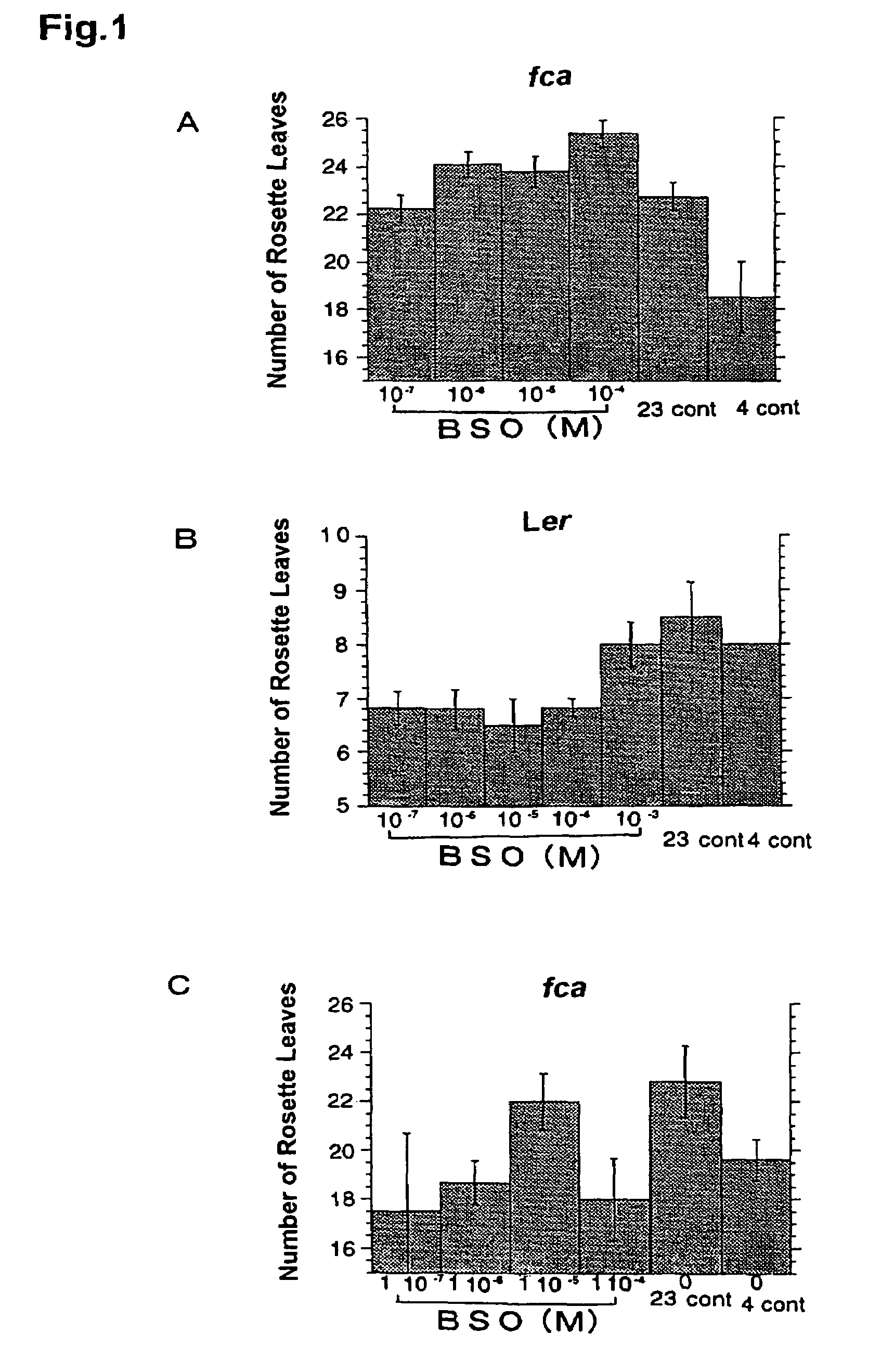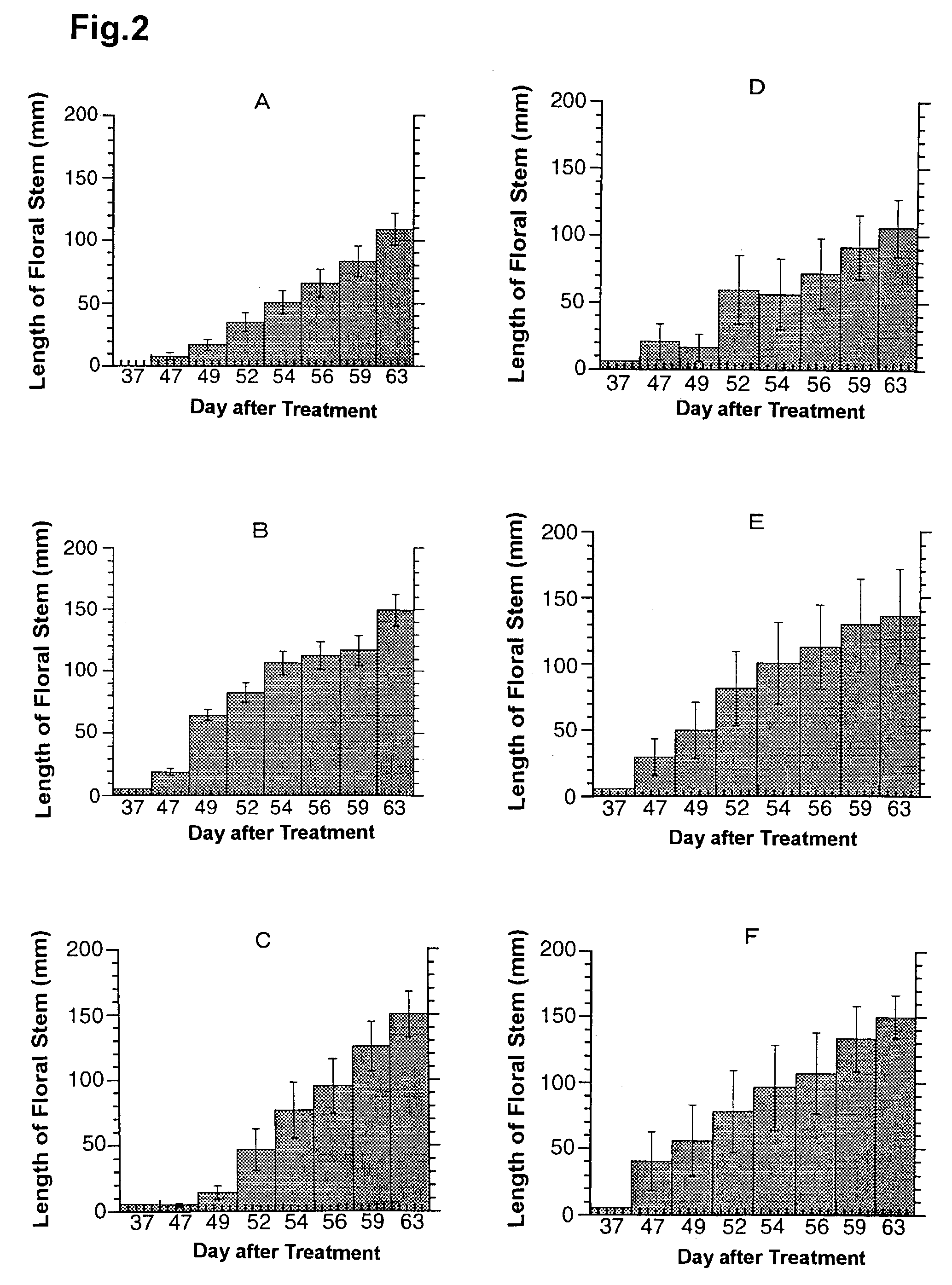Cell-or organ-differentiation controllers and method of controlling morphogenesis by using the same
- Summary
- Abstract
- Description
- Claims
- Application Information
AI Technical Summary
Benefits of technology
Problems solved by technology
Method used
Image
Examples
example 1
Regulation of Flowering Time (1)
[0055]Arabidopsis thaliana late-flowering mutant fca (Accession No. N167) obtained from Arabidopsis Stock Center publicly established at the University of Nottingham (U.K.) and wild type plant Ler (Accession No. NW20) were grown at 23° C. under a day length condition of 16-h light / 8-h dark cycle at 100 μE / m2 light intensity and used in the experiments. As a medium, soil consisting of 2 Vermiculite (Asahi Kogyo), 2 Kureha molding for raising seedlings (KUREHA chemical industry Co., Ltd.) and 1 Vermiculite (Asahi Kogyo), which are stacked in layer as the lower, middle and the upper layers, respectively, was used.
[0056]As a redox-state regulator of cells, L-buthionine sulfoximine (BSO), which is a glutathione synthesis inhibitor, and glutathione were used in combination.
[0057]BSO Treatment:
[0058]BSO was dissolved in water at a final concentration of 10−1M and used as a stock solution. Then, the treatment solutions at 10−3-10−7M were prepared from the sto...
example 2
Regulation of Flowering Time (2)
[0067]Arabidopsis thaliana late-flowering mutant fca was grown in a manner similar to that described in Example 1 at 23° C. under the day length condition of 16-h light / 8-h dark cycle at 100 μE / m2 / s light intensity and used in the experiments.
[0068]As a redox-state regulator of cells, hydrogen peroxide was used at the concentrations indicated in FIG. 4. An aqueous solution of hydrogen peroxide was prepared immediately before use. Two to three plants were placed per a pot (about 40×50 mm). On 17 days after imbibition and thereafter, the treatment solution was added dropwise around the shoot apex at 5 ml / day per a pot. The treatments were performed on day 0 (the initiation date of treatment), 1, 3, 5 and 7, which set of treatments was regarded as one processing. The time of floral transition was compared using the rosette leaf number as an index. The results are shown in FIG. 4. In the figure, the 23 cont is the result of water treatment (control experi...
example 3
Regulation of Flowering Time (3)
[0071]Arabidopsis thaliana late-flowering mutant fca was grown in a manner similar to that described in Example 1 at 23° C. under a day length condition of 16-h light / 8-h dark cycle at 100 μE / m2 light intensity and used in the experiments.
[0072]As a redox-state regulator of cells, KCN or NaN3 was used. KCN or sodium azide was prepared immediately before use and used at concentrations described in FIG. 6 or 7, respectively. Two to three plants were placed per a pot (about 40×50 mm) and treatment solution was added dropwise around the shoot apex at 5 ml / day per a pot. KCN or NaN3 treatment was started 17 days after imbibition. The treatments were performed on day 0 (the initiation date of treatment), 1, 3, 5 and 7, which set of treatments was regarded as one processing. The time of floral transition was compared using the rosette leaf number as an index. The experimental results with KCN or NaN3 are shown in FIG. 6 and FIG. 7, respectively. In the figur...
PUM
| Property | Measurement | Unit |
|---|---|---|
| flowering time | aaaaa | aaaaa |
| concentration | aaaaa | aaaaa |
| temperature | aaaaa | aaaaa |
Abstract
Description
Claims
Application Information
 Login to View More
Login to View More - R&D
- Intellectual Property
- Life Sciences
- Materials
- Tech Scout
- Unparalleled Data Quality
- Higher Quality Content
- 60% Fewer Hallucinations
Browse by: Latest US Patents, China's latest patents, Technical Efficacy Thesaurus, Application Domain, Technology Topic, Popular Technical Reports.
© 2025 PatSnap. All rights reserved.Legal|Privacy policy|Modern Slavery Act Transparency Statement|Sitemap|About US| Contact US: help@patsnap.com



